The Secrets to Preventing Bud Rot
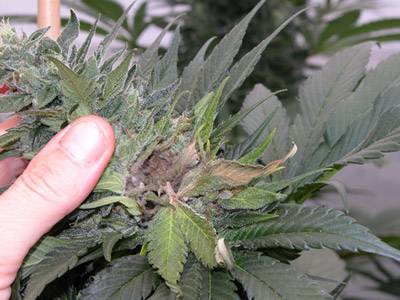
This entry will explain what we as outdoor growers can do to prevent fungal diseases from ever occurring, how they even manifest in the first place, and a few other things we can do in order to really ensure a healthy harvest. I know all of you hate clipping out botrytis buds as much as I do - there's no worse feeling than hiking out to your patch in October and being forced to leave half of the plant on the ground next to your stalk due to these different types of fungi. Before addressing this problem we must fully understand the process of infection in order to prevent it from ever happening. But before getting to that, I'll start by saying that the key to beating these pathogenic spores is by growing extremely healthy plants. A healthy plant cannot be infected. By anything. Not botrytis, not powdery mildew, not bacterial diseases (leaf spot), nothing. But before moving on, what do I mean by a "healthy plant"? You'll find it quite interesting how similar we humans are to our beloved cannabis plant, and all plants for that matter...
Plant & Human Immune Systems
First off, we must all understand that fungal/bacterial spores are everywhere we go; they're in the air at all times. In the time you took to read that first sentence you inhaled hundreds if not thousands of these spores. That's right! But wait, why aren't we getting sick from them? It's because we have functioning immune systems. I'm about to make a very eye-opening relation between human & plant health that too many growers aren't aware of, and it plays a HUGE role in preventing bud rot so bare with me here...
We as humans have a built-up resistance to pathogens that enter our bodies - solely due to these functioning immune systems. The majority of this system resides in our guts too, this comprises of millions and billions of gut flora (microorganisms). Microorganisms can be beneficial or non-beneficial by nature, so a healthy immune system simply means the beneficial populations are out-numbering the non-beneficial.
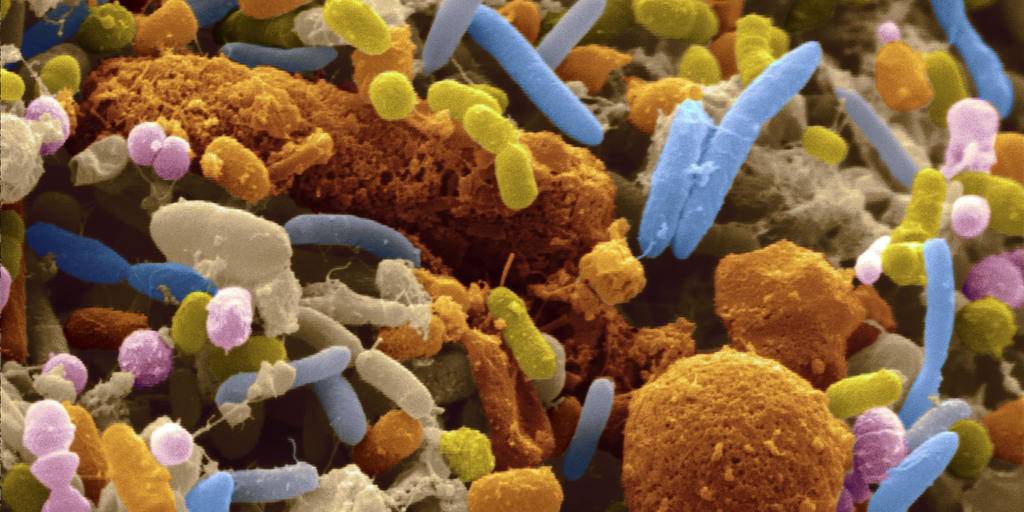
Beneficial gut bacteria
It is Nature's Law that every living organism has an immune system comprised of microorganisms. This is a very important fact to keep in the back of our heads while gardening because we are indeed working with nature, are we not? So with that being said, it is vital that we understand that plants are no different than any other living organism in that they too have functioning immune systems they rely on to maintain high levels of plant health. Human health is centered around the gut, while plant health is actually centered around the soil it grows in.
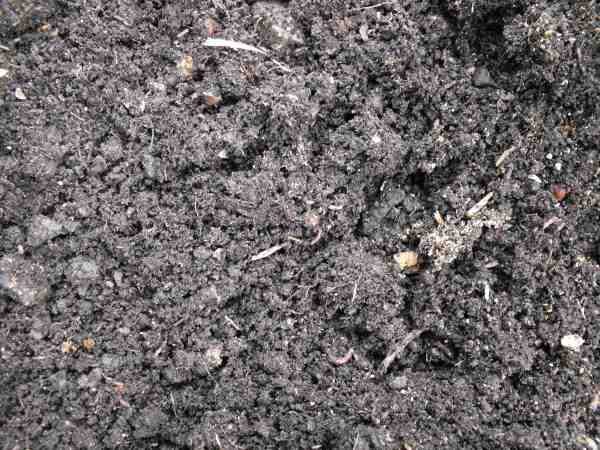
"Living organic soil"
Did you know that 1 tablespoon of soil in the forest contains more than 1 billion microorganisms?! It's true, and these are the very microorganisms that dictate whether the plants growing from it are sick or healthy. I like to call it my army - microbes are the key factor when it comes to plant health. I won't turn this into an organic soil post, but in short I can tell all of you hard-working growers out there that organic soil is your best friend. I look at the microbes as an army of defense while I'm not there, and without them my walls are bare and infiltration of fungi spores can and will occur at any time.
What if the plants aren't grown in soil though? What if there are no microorganisms present in the medium? Well, the best analogy I can think of is when a person goes through chemo-therapy. Feeding synthetic bottled nutrients and chemicals to a plant does the same thing chemo does to a patient - it kills the immune system. Wipes it out completely. Zero. Zilch. What happens when humans don't have a functioning immune system? You guessed it - infection occurs. The same goes with plants, when we don't provide that plant with any immunity then we're leaving it to fend for itself. That's why this thread really spoke to me, I felt like I really needed to let people know how I've beat the dreaded fungus and not only that but why I beat it - rather than listing a product or an integrated pest management regimen (which I will also be including later after this entry).
The Process of Infection
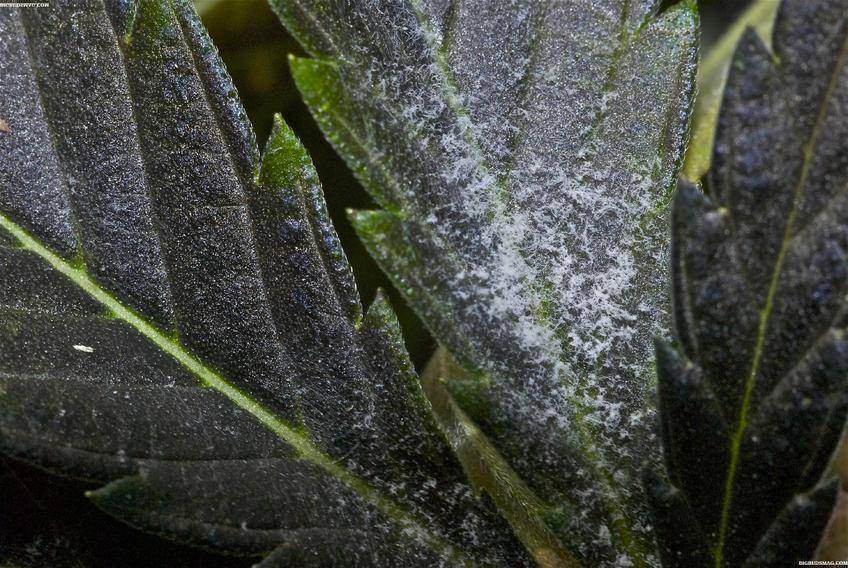
Powdery mildew post-infection
There are many genetic varieties of both Powdery Mildew and Botrytis but all persist through the winter months in the form of sclerotia or mycelia. In the spring, both the sclerotia and the myscelia produce conidiophores which grow millions of asexual spores (conidia) that are then spread by wind and rain. Like mentioned above, there is not avoiding these airborne spores. We breathe in, and even smoke some that land on our trees while we're rolling joints up everyday without second thought. Again, we have functioning immune systems to combat these pathogens - so the key to avoiding them from infecting our plants is to utilize the power of nature and grow in a well-balanced organic soil that contains all the necessary macro/micro nutrients. If we accomplish this step, the rest is Easy Street folks... it's that simple.
You see, when we grow plants with microorganisms in the soil that provide this functioning immunity for the plant - all worries of fungal and bacterial disease fly out the window. This is how - Healthy plants that are supplied with everything needed in the terms of macro/micro nutrients allow that plant to build up and store fats in the form of lipids. These lipids form on the coating of the leaves, and provide this waxy-looking film on them. This layer of lipids is KEY in fending off airborne spores. I repeat, this layer of lipids is KEY in fending off airborne spores. Without it, the leaf surface is susceptible to anything that lands on it.
So say for example I have 2 plants growing side by side in the same location, say a humid swamp environment for example. The healthy organic plant with functional immunity that has already stored lipids will grow in this swamp from seed to harvest without any disease or fungal outbreak, every single damn time. The plant next it grown with synthetic nutrients will allow every spore that lands on it's surface an opportunity to settle down, germinate, and spread infection to that plant systematically.
The way this happens is the spore lands on the leaf, and releases an enzyme called Calcium Pectate. This is just a fancy word meaning the enzyme has the ability to break down pectins. Once the spore has released this enzyme and the pectins are broken down, the leaf is now sporting what we would look at as a big flesh wound. Anything that gets inside that wound, or the plant in this case; will and can cause infection. This is why so many chemical and synthetic growers are having these problems, just like me when I was growing using these methods. The day I stopped feeding with chemicals and started adapting these organic regimens was the day I conquered bacterial & fungal airborne spores. I'm proud to say that I've been powdery mildew and botrytis-free since 2012, and you can too if you adopt these methods I and many others have to prevent bud rot or anything else from ever happening. Please trust me on this folks, I've been through hell and back and I'm here to report on my findings in hopes to stop at least one grower from leaving a pile of bud at each of their holes next October.
My personal experience
You're probably wondering why I'm a nerd on this stuff, and what led me down this path. Long story short, I had a pretty bad outbreak 3 seasons ago and when I dried the crop indoors it spread to my indoor crop as well. This was a very low point in my grow career, I literally broke down and considered shutting down my indoor grow and saying "fuck it" to next year's outdoor. I got drunk out of spite that night, went to bed and woke up the next day with some hidden motivation that I pulled out of somewhere and decided to push my ego to the side and admit I wasn't a very knowledgable grower. This was an extremely humbling experience, and I didn't know how to handle it since I was pretty cocky beforehand. It's like I've lost my credibility as a grower, at least in my own eyes.
Anyways, before this PM outbreak from Hell I lost 40% of my crop the year prior to Botrytis. I just thought that's the way it goes, and everyone has to go through it. Boy was I wrong...
In both 2013 & 2014 I came out 100% mold free. This was ground breaking for me, I literally cried the first day I harvested in '13. I walked out there, and the first plant I approached was with gloves and scissors in hand just ready to clip out my losses for the season. But what was this?! No mildew? No botrytis? Not possible I thought. I had followed some grower's advice on switching to organic soil, but I didn't think that was the reason for my success at that point in time. I busted out my headlamp and inspected again. Nothing. Completely clean herb. I got excited and wanted to celebrate but I figured it was just that plant/strain. 2nd plant was clean, and the 3rd, and the 4th, and 5th. All 20 plants were completely mold-free and I had an entirely different problem on my hands now - too MUCH bud. I had planned for only taking back half of that harvest and now I had too many pounds of bud to dry at my home location. I ended up making 2 sessions out of it, and dried the 2nd batch a few weeks after the 1st one. When I went back for the 2nd half of the crop on October 22nd there still wasn't any mold, and we had gotten a few heavy rain storms in that period of time. I celebrated when I got home, and with the harvest money I threw everything out that I had in the grow room and switched over to an all-organic routine. I've been running soil ever since...
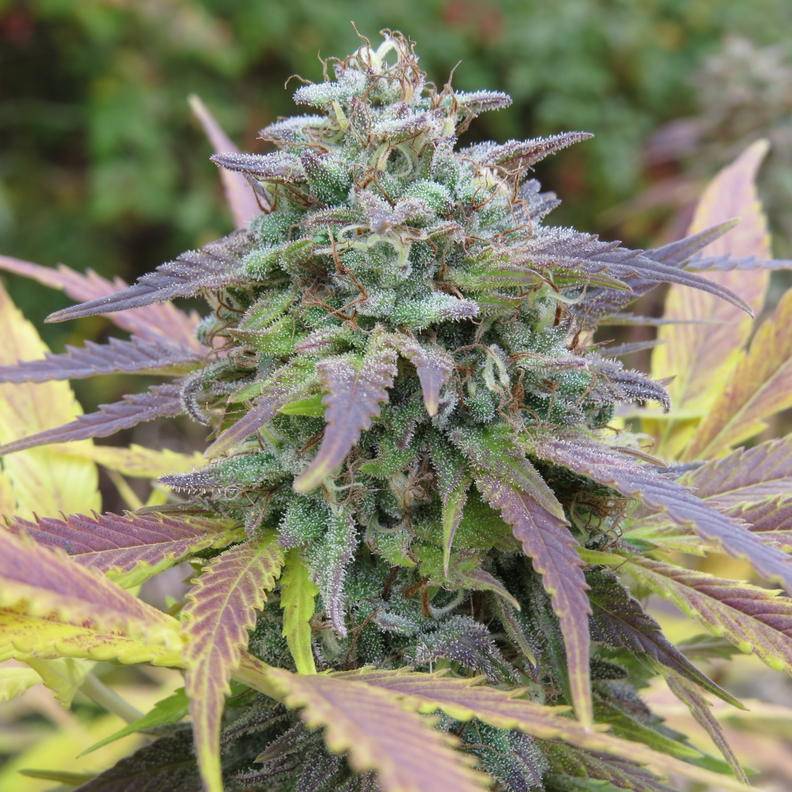
Blue Widow grown in soil down in the swamp (2014)
The swamps I grew in for 2013/2014 in were the same I've grown in the years before, the same ones that suffer from lingering A.M. humidity and fog. Moisture always gathers at the lowest elevation, and this swamp was IT in that area. I took a hygrometer out there one morning on Day 50 of flowering and it read 92% relative humidity. So I was growing in insane conditions, but the organic routine I've been following for the past 2 years has simply allowed the plants to reach peak health (or what I call peak genetic potential), thus eliminating any possibility of fungal pathogens to bypass the lipid-producing waxy layer on the leaves in order to germinate. They simply dried out due to lack of water!
This method of growing not only saves the grower from worrying about whether or not they're going to harvest a bumper crop that year, but it also opens up the doors when it comes to possible site locations. We can absolutely grow in these humid environments like swamps and bogs, without worrying about fungal take-overs. This puts the guerrilla at an extreme advantage in the outdoor game, because they now have the option of any clandestine location that they want (for the most part) instead of ruling these locations out due to high humidity levels in the air.
References used in this entry:
John Kempf's Bio Nutrient conference (Parts 1,2,3,4)
This entry will explain what we as outdoor growers can do to prevent fungal diseases from ever occurring, how they even manifest in the first place, and a few other things we can do in order to really ensure a healthy harvest. I know all of you hate clipping out botrytis buds as much as I do - there's no worse feeling than hiking out to your patch in October and being forced to leave half of the plant on the ground next to your stalk due to these different types of fungi. Before addressing this problem we must fully understand the process of infection in order to prevent it from ever happening. But before getting to that, I'll start by saying that the key to beating these pathogenic spores is by growing extremely healthy plants. A healthy plant cannot be infected. By anything. Not botrytis, not powdery mildew, not bacterial diseases (leaf spot), nothing. But before moving on, what do I mean by a "healthy plant"? You'll find it quite interesting how similar we humans are to our beloved cannabis plant, and all plants for that matter...
Plant & Human Immune Systems
First off, we must all understand that fungal/bacterial spores are everywhere we go; they're in the air at all times. In the time you took to read that first sentence you inhaled hundreds if not thousands of these spores. That's right! But wait, why aren't we getting sick from them? It's because we have functioning immune systems. I'm about to make a very eye-opening relation between human & plant health that too many growers aren't aware of, and it plays a HUGE role in preventing bud rot so bare with me here...
We as humans have a built-up resistance to pathogens that enter our bodies - solely due to these functioning immune systems. The majority of this system resides in our guts too, this comprises of millions and billions of gut flora (microorganisms). Microorganisms can be beneficial or non-beneficial by nature, so a healthy immune system simply means the beneficial populations are out-numbering the non-beneficial.
Beneficial gut bacteria
It is Nature's Law that every living organism has an immune system comprised of microorganisms. This is a very important fact to keep in the back of our heads while gardening because we are indeed working with nature, are we not? So with that being said, it is vital that we understand that plants are no different than any other living organism in that they too have functioning immune systems they rely on to maintain high levels of plant health. Human health is centered around the gut, while plant health is actually centered around the soil it grows in.
"Living organic soil"
Did you know that 1 tablespoon of soil in the forest contains more than 1 billion microorganisms?! It's true, and these are the very microorganisms that dictate whether the plants growing from it are sick or healthy. I like to call it my army - microbes are the key factor when it comes to plant health. I won't turn this into an organic soil post, but in short I can tell all of you hard-working growers out there that organic soil is your best friend. I look at the microbes as an army of defense while I'm not there, and without them my walls are bare and infiltration of fungi spores can and will occur at any time.
What if the plants aren't grown in soil though? What if there are no microorganisms present in the medium? Well, the best analogy I can think of is when a person goes through chemo-therapy. Feeding synthetic bottled nutrients and chemicals to a plant does the same thing chemo does to a patient - it kills the immune system. Wipes it out completely. Zero. Zilch. What happens when humans don't have a functioning immune system? You guessed it - infection occurs. The same goes with plants, when we don't provide that plant with any immunity then we're leaving it to fend for itself. That's why this thread really spoke to me, I felt like I really needed to let people know how I've beat the dreaded fungus and not only that but why I beat it - rather than listing a product or an integrated pest management regimen (which I will also be including later after this entry).
The Process of Infection
Powdery mildew post-infection
There are many genetic varieties of both Powdery Mildew and Botrytis but all persist through the winter months in the form of sclerotia or mycelia. In the spring, both the sclerotia and the myscelia produce conidiophores which grow millions of asexual spores (conidia) that are then spread by wind and rain. Like mentioned above, there is not avoiding these airborne spores. We breathe in, and even smoke some that land on our trees while we're rolling joints up everyday without second thought. Again, we have functioning immune systems to combat these pathogens - so the key to avoiding them from infecting our plants is to utilize the power of nature and grow in a well-balanced organic soil that contains all the necessary macro/micro nutrients. If we accomplish this step, the rest is Easy Street folks... it's that simple.
You see, when we grow plants with microorganisms in the soil that provide this functioning immunity for the plant - all worries of fungal and bacterial disease fly out the window. This is how - Healthy plants that are supplied with everything needed in the terms of macro/micro nutrients allow that plant to build up and store fats in the form of lipids. These lipids form on the coating of the leaves, and provide this waxy-looking film on them. This layer of lipids is KEY in fending off airborne spores. I repeat, this layer of lipids is KEY in fending off airborne spores. Without it, the leaf surface is susceptible to anything that lands on it.
So say for example I have 2 plants growing side by side in the same location, say a humid swamp environment for example. The healthy organic plant with functional immunity that has already stored lipids will grow in this swamp from seed to harvest without any disease or fungal outbreak, every single damn time. The plant next it grown with synthetic nutrients will allow every spore that lands on it's surface an opportunity to settle down, germinate, and spread infection to that plant systematically.
The way this happens is the spore lands on the leaf, and releases an enzyme called Calcium Pectate. This is just a fancy word meaning the enzyme has the ability to break down pectins. Once the spore has released this enzyme and the pectins are broken down, the leaf is now sporting what we would look at as a big flesh wound. Anything that gets inside that wound, or the plant in this case; will and can cause infection. This is why so many chemical and synthetic growers are having these problems, just like me when I was growing using these methods. The day I stopped feeding with chemicals and started adapting these organic regimens was the day I conquered bacterial & fungal airborne spores. I'm proud to say that I've been powdery mildew and botrytis-free since 2012, and you can too if you adopt these methods I and many others have to prevent bud rot or anything else from ever happening. Please trust me on this folks, I've been through hell and back and I'm here to report on my findings in hopes to stop at least one grower from leaving a pile of bud at each of their holes next October.
My personal experience
You're probably wondering why I'm a nerd on this stuff, and what led me down this path. Long story short, I had a pretty bad outbreak 3 seasons ago and when I dried the crop indoors it spread to my indoor crop as well. This was a very low point in my grow career, I literally broke down and considered shutting down my indoor grow and saying "fuck it" to next year's outdoor. I got drunk out of spite that night, went to bed and woke up the next day with some hidden motivation that I pulled out of somewhere and decided to push my ego to the side and admit I wasn't a very knowledgable grower. This was an extremely humbling experience, and I didn't know how to handle it since I was pretty cocky beforehand. It's like I've lost my credibility as a grower, at least in my own eyes.
Anyways, before this PM outbreak from Hell I lost 40% of my crop the year prior to Botrytis. I just thought that's the way it goes, and everyone has to go through it. Boy was I wrong...
In both 2013 & 2014 I came out 100% mold free. This was ground breaking for me, I literally cried the first day I harvested in '13. I walked out there, and the first plant I approached was with gloves and scissors in hand just ready to clip out my losses for the season. But what was this?! No mildew? No botrytis? Not possible I thought. I had followed some grower's advice on switching to organic soil, but I didn't think that was the reason for my success at that point in time. I busted out my headlamp and inspected again. Nothing. Completely clean herb. I got excited and wanted to celebrate but I figured it was just that plant/strain. 2nd plant was clean, and the 3rd, and the 4th, and 5th. All 20 plants were completely mold-free and I had an entirely different problem on my hands now - too MUCH bud. I had planned for only taking back half of that harvest and now I had too many pounds of bud to dry at my home location. I ended up making 2 sessions out of it, and dried the 2nd batch a few weeks after the 1st one. When I went back for the 2nd half of the crop on October 22nd there still wasn't any mold, and we had gotten a few heavy rain storms in that period of time. I celebrated when I got home, and with the harvest money I threw everything out that I had in the grow room and switched over to an all-organic routine. I've been running soil ever since...
Blue Widow grown in soil down in the swamp (2014)
The swamps I grew in for 2013/2014 in were the same I've grown in the years before, the same ones that suffer from lingering A.M. humidity and fog. Moisture always gathers at the lowest elevation, and this swamp was IT in that area. I took a hygrometer out there one morning on Day 50 of flowering and it read 92% relative humidity. So I was growing in insane conditions, but the organic routine I've been following for the past 2 years has simply allowed the plants to reach peak health (or what I call peak genetic potential), thus eliminating any possibility of fungal pathogens to bypass the lipid-producing waxy layer on the leaves in order to germinate. They simply dried out due to lack of water!
This method of growing not only saves the grower from worrying about whether or not they're going to harvest a bumper crop that year, but it also opens up the doors when it comes to possible site locations. We can absolutely grow in these humid environments like swamps and bogs, without worrying about fungal take-overs. This puts the guerrilla at an extreme advantage in the outdoor game, because they now have the option of any clandestine location that they want (for the most part) instead of ruling these locations out due to high humidity levels in the air.
References used in this entry:
John Kempf's Bio Nutrient conference (Parts 1,2,3,4)



